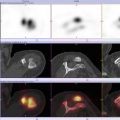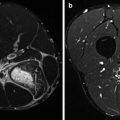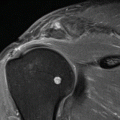16.4.2 Chronic Shoulder Pain
Chronic shoulder pain is probably the most common arm problem in recreational and competitive overhead athletes. Throwing athletes need full, unrestricted arm function to optimally perform in their sport. Nontraumatic shoulder pain in the overhead athlete is a diagnostic challenge. The causes of chronic shoulder pain are numerous but often difficult to identify and diagnose. Research indicates that shoulder impingement is the most common cause of shoulder pain in overhead athletes (Cools et al. 2008b). In recent literature, impingement has been described as a group of symptoms rather than a specific diagnosis (Cools et al. 2008a). In this current opinion, it is thought that numerous underlying pathologies may cause impingement symptoms. Glenohumeral instability, rotator cuff or biceps pathology, scapular dyskinesis, and glenohumeral internal rotation deficit have been associated with impingement symptoms in clinical literature (Cools et al. 2008a; Kibler 1998). Various anatomical structures can be impinged internally or externally, probably depending on the motion and loading put on the shoulder during the pain-provoking activity. However, a possible instability in the shoulder is often “silent” and difficult to show by ordinary tests and has therefore by some been termed “functional instability” (Castagna et al. 2010; Jobe et al. 1989). It is now thought that functional instability in the shoulder may lead to a vicious circle involving microtrauma and secondary impingement and may eventually lead to chronic shoulder pain. Since the first paper, published by Walch et al. (1992), describing a new site of impingement between the humeral head and the posterosuperior rim of the glenoid, internal superior glenoid-type impingement has been suggested to be a common cause of chronic shoulder disorder in overhead athletes. This type of impingement occurs in the cocking position of throwing, with the glenohumeral joint in maximal external rotation, in maximum horizontal abduction, and, depending on the sport, in abduction or forward flexion (Cools et al. 2008b). In general, overhead athletes with internal impingement have posterior shoulder pain and tenderness of the infraspinatus tendon on palpation. Internal superior glenoid impingement particularly occurs when the humeral shaft goes beyond the plane of the body of the scapula during the cocking position of throwing (Wilk et al. 2009a). Under normal circumstances, the scapula goes into retraction simultaneously with the horizontal abduction movement of the humerus. When the body of the scapula and the humeral shaft fail to remain in the same plane of movement during the cocking phase of throwing, encroachment of the rotator cuff tendons between the humeral head and the glenoid rim may cause internal impingement symptoms. This phenomenon is called “hyperangulation.” However, in spite of the documented structural pathology and cuff lesions (Walch et al. 1992), shown by several groups to be related to internal superior glenoid impingement symptoms, it is suggested that functional disturbances, such as subtle glenohumeral instability, glenohumeral range of motion (ROM) restrictions, scapular dysfunction, and muscle stiffness, are often associated with internal impingement symptoms, rather than structural deficits and pathologies (Cools et al. 2008b; Tyler et al. 2010). Another type of impingement, subcoracoid impingement, has been described related to anterior shoulder pain and subscapularis tendon tears. However, the pathogenesis has still not been explained properly. Subcoracoid stenosis and anterosuperior translations of the humeral head, both resulting in narrowing of the coracohumeral space, may lead to anterosuperior tears of the cuff including the subscapularis tendon. Symptoms particularly occur during the deceleration and follow-through phases of throwing.
16.5 Examination
In view of the assumption that impingement symptoms may be the result of various underlying pathologies, it is important to understand the biomechanical relationship between these symptoms and shoulder diagnoses. Since functional deficits rather than structural pathology often are the underlying cause of chronic shoulder pain in the overhead athlete, the clinical examination of the patient is very important.
The physical examination of the overhead athlete consists initially of a thorough history (or subjective assessment); inspection; active, passive, and resistance tests; and pre- and post-examination palpation. During the physical examination of the athlete with shoulder pain, it is imperative that the investigator examines what kind of impingement the patient suffers from and what the underlying pathology might be. Several papers offer the clinician an approach to specific tests that can be used when screening the athlete’s shoulder for impingement-related shoulder problems (Cools et al. 2008a; Hegedus et al. 2012). All the clinical tests described in the following paragraphs are summarized in Table 16.1.
Impingement | Neer | Forced passive forward flexion with the arm internally rotated and caudal pressure on the acromion |
Hawkins | Passive internal rotation from a 90° forward flexed position | |
Jobe | Resisted elevation in the scapular plane with the shoulder in maximal internal rotation | |
Rotator cuff | Full can | Resisted elevation in the scapular plane with the shoulder in external rotation (thumbs up) |
External rotation lag sign | Arm in slight elevation and external rotation: patient is asked to keep this position against gravity | |
Hornblower’s sign | An inability to externally rotate the elevated arm | |
Lift-off test | Arm in full internal rotation on the back, patient is asked to lift off his/her hand from the back | |
Belly-press test | Patient is asked to push his/her hand into his/her belly with the elbow aside, inability to keep the elbow steady | |
Scapular involvement | Scapular assistance test | Patient performs active elevation while examiner manually assists scapular upward rotation and posterior tilting |
Scapular retraction test | Patient performs Jobe test while examiner manually stabilizes the scapula into retraction against the thoracic wall | |
Instability | Apprehension | Patient exhibits apprehensive muscle tension during the position of 90° abduction-90° external rotation |
Relocation | Dorsal pressure on humeral head in the apprehension position gives symptom relief | |
Release | Symptoms of instability when hand is released from the patient’s shoulder after the relocation test | |
Load and shift | Passive anterior translation of the humeral head with respect to the glenoid results in subluxation | |
Sulcus | Examiner induces caudal translation on the humeral head by pulling on the elbow down; this results in a sulcus at the level of the glenohumeral joint | |
Posterior subluxation test | Performing a dorsal pressure while the shoulder is in horizontal adduction results in posterior subluxation | |
Hyperabduction test | Examiner performs abduction >90° while fixing the acromion and the clavicle caudally | |
SLAP and biceps pathology | O’Brien test | Resisted elevation in two positions: 10° horizontal adduction thumb down (1) and thumb up (2), pain only during first position |
Biceps load II test | Resisted elbow flexion while shoulder is in 120° abduction, external rotation, elbow 90° flexed and full supination | |
Yergason test | Resisted supination results in pain in bicipital groove | |
Dynamic labral shear test | Examiner applies a shear load to the joint by maintaining external rotation and horizontal abduction and lowering the arm from 120° to 60° abduction | |
GIRD | ROM measurement | Left-right comparison of internal rotation with the arm 90° abducted in the frontal plane |
16.5.1 Impingement Tests
Of the various provocative impingement tests, the most popular are the Jobe, Hawkins, and Neer tests. These tests show high sensitivity, however questionable specificity, and should therefore only be used as a first screening tool to confirm the presence of impingement-related shoulder pain. Besides these impingement tests, very often, instability tests (apprehension, relocation, release) are used as provocation tests for impingement, interpreting them with respect to pain rather than instability symptoms, to further define the cause of impingement. In general it is suggested that at least three tests should be positive to draw conclusions regarding impingement symptoms (Cools et al. 2008a; Hegedus et al. 2012; Meister et al. 2004).
Stay updated, free articles. Join our Telegram channel

Full access? Get Clinical Tree







